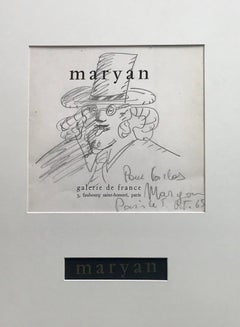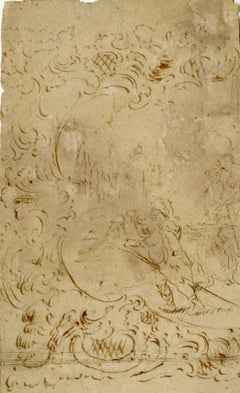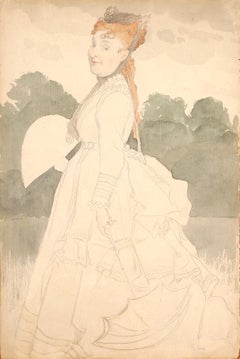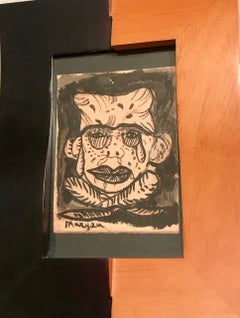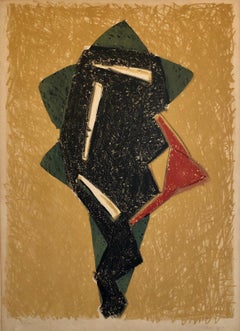Pinchas Maryan Figurative Drawings and Watercolors
to
2
1
1
2
Overall Height
to
Overall Width
to
1
2
1
1
1
1
1
2
1
1
9
683
326
196
132
1
1
1
Artist: Pinchas Maryan
MARYAN - ORIGINAL DRAWING - PORTRAIT
By Pinchas Maryan
Located in Tel Aviv - Jaffa, IL
Ink on paper
Hand signed and dated lower right
Unique piece
Category
1970s Expressionist Pinchas Maryan Figurative Drawings and Watercolors
Materials
Ink
MARYAN
By Pinchas Maryan
Located in Tel Aviv - Jaffa, IL
Original drawing with pencil by the Master
Hand signed , dedicated and dated by the artist
Unique piece
Professionally framed
Provenance ; Catalogued auction french auction...
Category
1960s French School Pinchas Maryan Figurative Drawings and Watercolors
Materials
Carbon Pencil
Related Items
Design for a theatre fresco with fancy plasterwork - early 18th century French S
Located in Middletown, NY
Pen and sepia ink on cream laid paper, 8 3/4 x 5 3/8 inches (222 x 136 mm). Scattered paper tape repairs on the verso in the area of the upper left corner, and along the right sheet...
Category
Early 18th Century French School Pinchas Maryan Figurative Drawings and Watercolors
Materials
Ink, Laid Paper
Portrait of Lady Eugène Pegg walking in Saint Germain park (Paris)
By James Tissot
Located in BELEYMAS, FR
James TISSOT
(Nantes 1836 – Chenecey-Buillon 1902)
Madame Eugène Pegg walking at Saint Germain
H. 49 cm; L. 32 cm
Watercolor over pencil lines
Titled, located and dated on the back
...
Category
1870s French School Pinchas Maryan Figurative Drawings and Watercolors
Materials
Paper, Charcoal, Watercolor
Free Shipping
H 19.3 in W 12.6 in
Pastel, Ink Drawing Rocks And Cloud Landscape Jewish American Modernist WPA
By Ben-Zion Weinman
Located in Surfside, FL
Miniature Landscape
Provenance: Virginia Field, Arts administrator; New York, N.Y. Assistant director for Asia House gallery. (she was friends with John von Wicht and Andy Warhol)
Born in 1897, Ben-Zion Weinman celebrated his European Jewish heritage in his visual works as a sculptor, painter, and printmaker. Influenced by Spinoza, Knut Hamsun, and Wladyslaw Reymont, as well as Hebrew literature, Ben-Zion wrote poetry and essays that, like his visual work, attempt to reveal the deep “connection between man and the divine, and between man and earth.”
An emigrant from the Ukraine, he came to the US in 1920. He wrote fairy tales and poems in Hebrew under the name Benzion Weinman, but when he began painting he dropped his last name and hyphenated his first, saying an artist needed only one name.
Ben-Zion was a founding member of “The Ten: An Independent Group” The Ten” a 1930’s avant-garde group, Painted on anything handy. Ben-Zion often used cabinet doors (panels) in his work. Other members of group included Ilya Bolotowsky, Lee Gatch, Adolf Gottlieb, Louis Harris, Yankel Kufeld, Marcus Rothkowitz (later known as Mark Rothko), Louis Schanker, and Joseph Solman. The Art of “The Ten” was generally described as expressionist, as this style offered the best link between modernism and social art. Their exhibition at the Mercury Gallery in New York held at the same time as the Whitney Annual Exhibition of Contemporary American Painting, included a manifesto concentrating on aesthetic questions and criticisms of the conservative definition of modern art imposed by the Whitney. Ben-Zion’s work was quickly noticed. The New York Sun said he painted “furiously” and called him “the farthest along of the lot.” And the triptych, “The Glory of War,” was described by Art News as “resounding.”
By 1939, The Ten disbanded because most of the members found individual galleries to represent their work. Ben-Zion had his first one-man show at the Artist’s Gallery in Greenwich Village and J.B. Neumann, the highly esteemed European art dealer who introduced Paul Klee, (among others) to America, purchased several of Ben-Zion’s drawings. Curt Valentin, another well-known dealer, exhibited groups of his drawings and undertook the printing of four portfolios of etchings, each composed of Ben-Zion’s biblical themes.
Ben-Zion’s work is represented in many museums throughout the country including the Metropolitan, the Whitney, and the Museum of Modern Art in New York, the Art Institute of Chicago, the Philadelphia Museum of Art and the Phillips Collection, Washington. The Jewish Museum in New York opened in 1948 with a Ben-Zion exhibition.
“Ben-Zion has his hands on the pulse of the common man and his natural world”
As he emerged as an artist Ben-Zion never lost his gift for presenting the ordinary in ways that are vital, fresh and filled with emotions that are somber and exhilarating, joyous and thoughtful, and ultimately, filled with extraordinary poetic simplicity.
Ben-Zion consistently threaded certain subject matter—nature, still life, the human figure, the Hebrew Bible, and the Jewish people—into his work throughout his life. "In all his work a profound human feeling remains. Sea and sky, even sheaves of wheat acquire a monolithic beauty and simplicity which delineates the transient as a reflection of the eternal. This sensitive inter- mingling of the physical and metaphysical is one of the most enduring features of Ben-Zion's works." (Excerpt from Stephen Kayser, “Biblical Paintings,” The Jewish Museum Catalogue, 1952).
Along with ben Shahn, William Gropper, Chaim Gross and Abraham Rattner he was an influential mid century Jewish American...
Category
Mid-20th Century Expressionist Pinchas Maryan Figurative Drawings and Watercolors
Materials
Pastel, Ink, Watercolor
Portrait of a Gentleman in a Redingote by student od Jean Louis David drawing
Located in Norwich, GB
An exceptional ink, wash and graphite portrait of a gentleman by Henri-Joseph Hesse, dating from circa 1820, the time of the Bourbon restoration in France. It depicts a dashing figur...
Category
Early 19th Century French School Pinchas Maryan Figurative Drawings and Watercolors
Materials
Ink, Paper, Graphite
H 13.78 in W 11.82 in D 0.4 in
Military Drawing 19th Ink on paper Souvenir barrack officers 1830 July Monarchy
By Richard de Querelle
Located in PARIS, FR
Richard de QUERELLES Neuviller (Bas-Rhin), 1808 - Paris, 1846
Drawing Pen and ink 17.5 x 19 cm (28 x 37.5 cm with the frame) Signed "R. de Querelles ” and untitled“ Barraque ”
Henri...
Category
1830s French School Pinchas Maryan Figurative Drawings and Watercolors
Materials
Ink
The Hypochondriac: French 19th Century Theatre Comedy drawing
By Paul Gavarni (Guillaume Sulpice Chevalier)
Located in Norwich, GB
A magnificent and sensitively treated line drawing in coloured ink, heightened with white. It depicts Argan, the hypochondriac from Molière's play of the same name. Dating from circa...
Category
Mid-19th Century French School Pinchas Maryan Figurative Drawings and Watercolors
Materials
Ink, Paper, Gouache
H 14.57 in W 11.42 in D 0.4 in
Expressionist Miniature Drawing Wheat Stalks American Modernist Ben Zion WPA
By Ben-Zion Weinman
Located in Surfside, FL
Expressionist ink drawing of wheat stalks
There is an inscription "Happy New Year" on verso
Hand signed
Framed it measures 7.75 X 5.75
The actual paper is 3 X 3.5
Born in 1897, Ben-Zion Weinman celebrated his European Jewish heritage in his visual works as a sculptor, painter, and printmaker. Influenced by Spinoza, Knut Hamsun, and Wladyslaw Reymont, as well as Hebrew literature, Ben-Zion wrote poetry and essays that, like his visual work, attempt to reveal the deep “connection between man and the divine, and between man and earth.” An emigrant from the Ukraine, he came to the US in 1920. He wrote fairy tales and poems in Hebrew under the name Benzion Weinman, but when he began painting he dropped his last name and hyphenated his first, saying an artist needed only one name.
Ben-Zion was a founding member of “The Ten: An Independent Group” The Ten” a 1930’s avant-garde group, Painted on anything handy. Ben-Zion often used cabinet doors (panels) in his work. Other members of group included Ilya Bolotowsky, Lee Gatch, Adolph Gottlieb, Louis Harris, Yankel Kufeld, Marcus Rothkowitz (later known as Mark Rothko), Louis Schanker, and Joseph Solman. The Art of “The Ten” was generally described as expressionist, as this style offered the best link between modernism and social art. Their exhibition at the Mercury Gallery in New York held at the same time as the Whitney Annual Exhibition of Contemporary American Painting, included a manifesto concentrating on aesthetic questions and criticisms of the conservative definition of modern art imposed by the Whitney. Ben-Zion’s work was quickly noticed. The New York Sun said he painted “furiously” and called him “the farthest along of the lot.” And the triptych, “The Glory of War,” was described by Art News as “resounding.”
By 1939, The Ten disbanded because most of the members found individual galleries to represent their work. Ben-Zion had his first one-man show at the Artist’s Gallery in Greenwich Village and J.B. Neumann, the highly esteemed European art dealer who introduced Paul Klee, (among others) to America, purchased several of Ben-Zion’s drawings. Curt Valentin, another well-known dealer, exhibited groups of his drawings and undertook the printing of four portfolios of etchings, each composed of Ben-Zion’s biblical themes. He worked as a WPA artist.
Ben-Zion’s work is represented in many museums throughout the country including the Metropolitan, the Whitney, and the Museum of Modern Art in New York, the Art Institute of Chicago, the Philadelphia Museum of Art and the Phillips Collection, Washington. The Jewish Museum in New York opened in 1948 with a Ben-Zion exhibition.
Ben-Zion consistently threaded certain subject matter—nature, still life, the human figure, the Hebrew Bible, and the Jewish people—into his work throughout his life. "In all his work a profound human feeling remains. Sea and sky, even sheaves of wheat acquire a monolithic beauty and simplicity which delineates the transient as a reflection of the eternal. This sensitive inter- mingling of the physical and metaphysical is one of the most enduring features of Ben-Zion's works." (Excerpt from Stephen Kayser, “Biblical Paintings,” The Jewish Museum Catalogue, 1952). Mystical Imprints: Marc Chagall, Ben-Zion, and Ben Shahn presents the print work of three prominent 20th century Jewish artists born in the Russian Empire. Among these seventy pieces are etchings and lithographs from Chagall’s Bible series...
Category
1950s Expressionist Pinchas Maryan Figurative Drawings and Watercolors
Materials
Ink
Convent interior
Located in PARIS, FR
Hippolyte Victor Valentin SEBRON
(Caudebec-en-Caux, 1801 – Paris, 1879)
Convent interior
Ink, pen and wash
Signed and dated lower left
27,5 x 20 cm
1839
Pupil of Daguerre from the age of 29, Sebron entered the Ecole des Beaux-Arts in Paris under the teaching of Cogniet. He exhibited regularly at the Paris Salon between 1831 and 1878.
First employed in the painting of dioramas, he then produced numerous paintings, particularly interiors of churches...
Category
Early 19th Century French School Pinchas Maryan Figurative Drawings and Watercolors
Materials
Ink, Pen
Expressionist Color Drawing Cobalt Glass Vintage Frame Modernist Ben Zion WPA
By Ben-Zion Weinman
Located in Surfside, FL
Expressionist ink and pastel crayon drawing of flowers in vase.
Framed in a vintage cobalt blue glass original frame
Hand signed and dated
Framed it measures 13.5 X 10.5
The actual paper is 7.5 X 5.5
Born in 1897, Ben-Zion Weinman celebrated his European Jewish heritage in his visual works as a sculptor, painter, and printmaker. Influenced by Spinoza, Knut Hamsun, and Wladyslaw Reymont, as well as Hebrew literature, Ben-Zion wrote poetry and essays that, like his visual work, attempt to reveal the deep “connection between man and the divine, and between man and earth.” An emigrant from the Ukraine, he came to the US in 1920. He wrote fairy tales and poems in Hebrew under the name Benzion Weinman, but when he began painting he dropped his last name and hyphenated his first, saying an artist needed only one name.
Ben-Zion was a founding member of “The Ten: An Independent Group” The Ten” a 1930’s avant-garde group, Painted on anything handy. Ben-Zion often used cabinet doors (panels) in his work. Other members of group included Ilya Bolotowsky, Lee Gatch, Adolph Gottlieb, Louis Harris, Yankel Kufeld, Marcus Rothkowitz (later known as Mark Rothko), Louis Schanker, and Joseph Solman. The Art of “The Ten” was generally described as expressionist, as this style offered the best link between modernism and social art. Their exhibition at the Mercury Gallery in New York held at the same time as the Whitney Annual Exhibition of Contemporary American Painting, included a manifesto concentrating on aesthetic questions and criticisms of the conservative definition of modern art imposed by the Whitney. Ben-Zion’s work was quickly noticed. The New York Sun said he painted “furiously” and called him “the farthest along of the lot.” And the triptych, “The Glory of War,” was described by Art News as “resounding.”
By 1939, The Ten disbanded because most of the members found individual galleries to represent their work. Ben-Zion had his first one-man show at the Artist’s Gallery in Greenwich Village and J.B. Neumann, the highly esteemed European art dealer who introduced Paul Klee, (among others) to America, purchased several of Ben-Zion’s drawings. Curt Valentin, another well-known dealer, exhibited groups of his drawings and undertook the printing of four portfolios of etchings, each composed of Ben-Zion’s biblical themes. He worked as a WPA artist.
Ben-Zion’s work is represented in many museums throughout the country including the Metropolitan, the Whitney, and the Museum of Modern Art in New York, the Art Institute of Chicago, the Philadelphia Museum of Art and the Phillips Collection, Washington. The Jewish Museum in New York opened in 1948 with a Ben-Zion exhibition.
Ben-Zion consistently threaded certain subject matter—nature, still life, the human figure, the Hebrew Bible, and the Jewish people—into his work throughout his life. "In all his work a profound human feeling remains. Sea and sky, even sheaves of wheat acquire a monolithic beauty and simplicity which delineates the transient as a reflection of the eternal. This sensitive inter- mingling of the physical and metaphysical is one of the most enduring features of Ben-Zion's works." (Excerpt from Stephen Kayser, “Biblical Paintings,” The Jewish Museum Catalogue, 1952). Mystical Imprints: Marc Chagall, Ben-Zion, and Ben Shahn presents the print work of three prominent 20th century Jewish artists born in the Russian Empire. Among these seventy pieces are etchings and lithographs from Chagall’s Bible series...
Category
1950s Expressionist Pinchas Maryan Figurative Drawings and Watercolors
Materials
Paper, Oil Crayon, Pastel, Ink
19th C. French Provincial Watercolor & Collage-Figures in a Pastoral Landscape
Located in Chicago, IL
A fine 19th Century, Continental watercolor and textile fabric collage, depicting an erotic figural group at leisure in a pastoral landscape. ...
Category
19th Century French School Pinchas Maryan Figurative Drawings and Watercolors
Materials
Fabric, Paper, Watercolor
The Introduction, French School, 18th century
Located in Middletown, NY
In this charming scene a maid appears bashful as she is introduced by her mother to the shepherd’s son.
Ink and wash on hand made, cool-toned cream laid paper, 6 3/4 x 8 7/8 inches...
Category
Mid-18th Century French School Pinchas Maryan Figurative Drawings and Watercolors
Materials
Ink, Watercolor, Handmade Paper, Laid Paper
Woman in thought and Child: the page boy intriguing 19th Century Master drawing
By Gustave Jean Jacquet
Located in Norwich, GB
A virtuoso charcoal sketch by the Frech 19th Century master Gustave Jean Jacquet (1846-1904). It depicts a thoughtful woman (or woman in thought?) with her face resting on her hand...
Category
Late 19th Century French School Pinchas Maryan Figurative Drawings and Watercolors
Materials
Charcoal, Laid Paper
H 17.33 in W 14.97 in D 0.4 in
Previously Available Items
No title
By Pinchas Maryan
Located in Tel Aviv - Jaffa, IL
Ink on paper
Signed lower left
Unique piece
Art Deco frame
Category
1970s Pinchas Maryan Figurative Drawings and Watercolors
Materials
Ink
Polish French Jewish Figurative Expressionist Abstract Geometric Lithograph
By Pinchas Maryan
Located in Surfside, FL
Maryan, Polish-born Jewish expressionist painter
Born in Poland in 1927 with the name of Pinchas Burstein, Maryan, became a modernist expression...
Category
1970s Expressionist Pinchas Maryan Figurative Drawings and Watercolors
Materials
Lithograph, Paper
Personnage, Polish French Figurative Expressionist Watercolor Painting
By Pinchas Maryan
Located in Surfside, FL
Watercolor and ink on paper. Label from George Adams Gallery included but detached.
Maryan, Polish-born Jewish expressionist painter
Born in Pol...
Category
1970s Expressionist Pinchas Maryan Figurative Drawings and Watercolors
Materials
Paper, Ink, Watercolor
Pinchas Maryan figurative drawings and watercolors for sale on 1stDibs.
Find a wide variety of authentic Pinchas Maryan figurative drawings and watercolors available for sale on 1stDibs. You can also browse by medium to find art by Pinchas Maryan in carbon pencil, ink, pencil and more. Much of the original work by this artist or collective was created during the 20th century and is mostly associated with the Expressionist style. Not every interior allows for large Pinchas Maryan figurative drawings and watercolors, so small editions measuring 9 inches across are available. Customers who are interested in this artist might also find the work of Louis Valtat, Bob Paul Kane, and Parmis Sayous. Pinchas Maryan figurative drawings and watercolors prices can differ depending upon medium, time period and other attributes. On 1stDibs, the price for these items starts at $2,000 and tops out at $5,000, while the average work can sell for $3,500.

